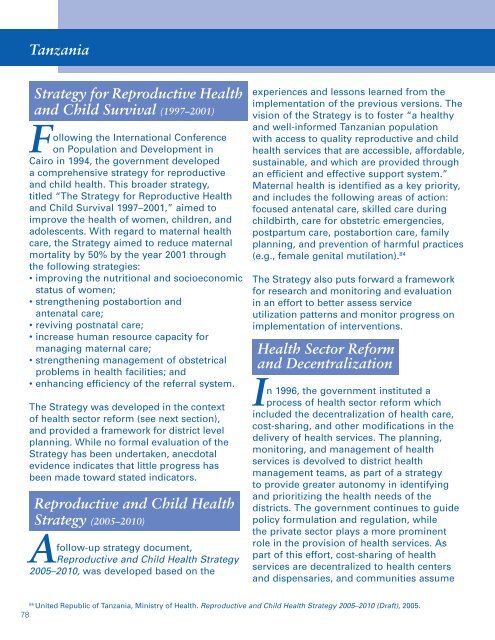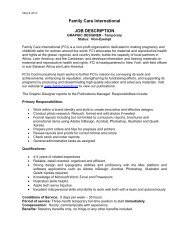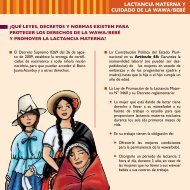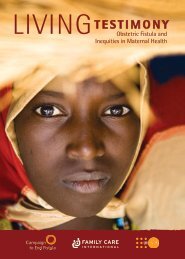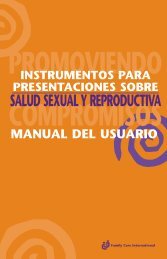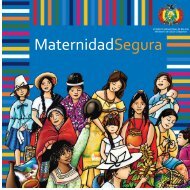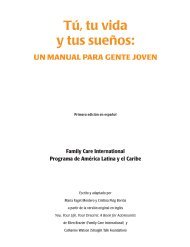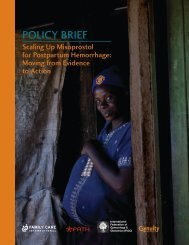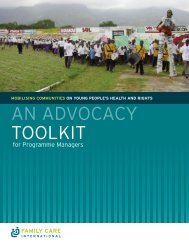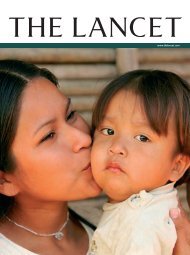Safe Motherhood: A Review - Family Care International
Safe Motherhood: A Review - Family Care International
Safe Motherhood: A Review - Family Care International
Create successful ePaper yourself
Turn your PDF publications into a flip-book with our unique Google optimized e-Paper software.
Tanzania<br />
Strategy for Reproductive Health<br />
and Child Survival (1997–2001)<br />
Following the <strong>International</strong> Conference<br />
on Population and Development in<br />
Cairo in 1994, the government developed<br />
a comprehensive strategy for reproductive<br />
and child health. This broader strategy,<br />
titled “The Strategy for Reproductive Health<br />
and Child Survival 1997–2001,” aimed to<br />
improve the health of women, children, and<br />
adolescents. With regard to maternal health<br />
care, the Strategy aimed to reduce maternal<br />
mortality by 50% by the year 2001 through<br />
the following strategies:<br />
• improving the nutritional and socioeconomic<br />
status of women;<br />
• strengthening postabortion and<br />
antenatal care;<br />
• reviving postnatal care;<br />
• increase human resource capacity for<br />
managing maternal care;<br />
• strengthening management of obstetrical<br />
problems in health facilities; and<br />
• enhancing efficiency of the referral system.<br />
The Strategy was developed in the context<br />
of health sector reform (see next section),<br />
and provided a framework for district level<br />
planning. While no formal evaluation of the<br />
Strategy has been undertaken, anecdotal<br />
evidence indicates that little progress has<br />
been made toward stated indicators.<br />
Reproductive and Child Health<br />
Strategy (2005–2010)<br />
A follow-up strategy document,<br />
Reproductive and Child Health Strategy<br />
2005–2010, was developed based on the<br />
experiences and lessons learned from the<br />
implementation of the previous versions. The<br />
vision of the Strategy is to foster “a healthy<br />
and well-informed Tanzanian population<br />
with access to quality reproductive and child<br />
health services that are accessible, affordable,<br />
sustainable, and which are provided through<br />
an efficient and effective support system.”<br />
Maternal health is identified as a key priority,<br />
and includes the following areas of action:<br />
focused antenatal care, skilled care during<br />
childbirth, care for obstetric emergencies,<br />
postpartum care, postabortion care, family<br />
planning, and prevention of harmful practices<br />
(e.g., female genital mutilation). 84<br />
The Strategy also puts forward a framework<br />
for research and monitoring and evaluation<br />
in an effort to better assess service<br />
utilization patterns and monitor progress on<br />
implementation of interventions.<br />
Health Sector Reform<br />
and Decentralization<br />
In 1996, the government instituted a<br />
process of health sector reform which<br />
included the decentralization of health care,<br />
cost-sharing, and other modifications in the<br />
delivery of health services. The planning,<br />
monitoring, and management of health<br />
services is devolved to district health<br />
management teams, as part of a strategy<br />
to provide greater autonomy in identifying<br />
and prioritizing the health needs of the<br />
districts. The government continues to guide<br />
policy formulation and regulation, while<br />
the private sector plays a more prominent<br />
role in the provision of health services. As<br />
part of this effort, cost-sharing of health<br />
services are decentralized to health centers<br />
and dispensaries, and communities assume<br />
84 United Republic of Tanzania, Ministry of Health. Reproductive and Child Health Strategy 2005–2010 (Draft), 2005.


